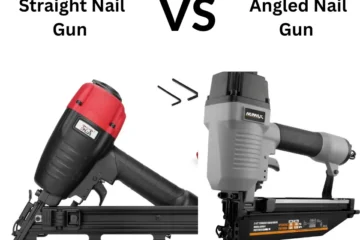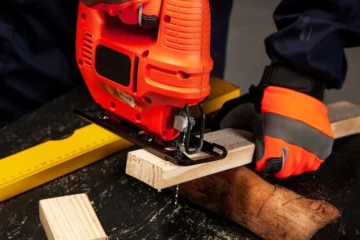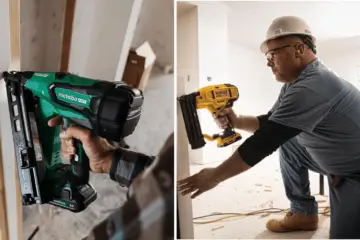When it comes to driving nails into wood or other materials, two primary tools come to mind: the nail gun and the hammer. The hammer, a tool dating back thousands of years, represents the traditional approach, relying on manual force and precision.
On the other hand, the nail gun, a more modern invention, offers speed and power, making it a favorite among professionals. But which is better? This blog post will delve into the details of both tools, comparing their functionality, efficiency, safety, and suitability for various tasks.
Understanding the Basics
What is a Nail Gun?
A nail gun, also known as a nailer, is a powerful tool that uses compressed air, electricity, or gas to drive nails into materials quickly and accurately. Nail guns come in various types, including pneumatic (air-powered), cordless (battery-powered), and electric (corded).
They are commonly used in construction, carpentry, roofing, and other heavy-duty tasks that require fastening materials together quickly.
What is a Hammer?
A hammer is a hand tool with a heavy metal head mounted at right angles at the end of a handle. It is used for driving nails into, or pulling nails from, some other object.
Hammers come in various sizes and styles, each designed for specific tasks. The claw hammer is the most common type, used in woodworking and general construction.
Nail Gun vs. Hammer: A Detailed Comparison
1. Speed and Efficiency
Nail Gun: Nail guns are known for their speed. A single trigger pull can drive a nail in a fraction of a second, making them ideal for large-scale projects. Professionals in the construction industry often prefer nail guns for tasks like framing, roofing, and installing baseboards, where speed is crucial.
Hammer: While a hammer requires more time and effort to drive each nail, it offers greater control and precision. For smaller projects, detailed work, or situations where only a few nails need to be driven, a hammer can be more efficient and less cumbersome.
2. Precision and Control
Nail Gun: Nail guns are incredibly precise when used correctly, but they require skill and experience to avoid mistakes. The force of the tool can sometimes cause nails to be driven too deep or at an incorrect angle. However, many nail guns come with depth adjustment settings that allow for more control.
Hammer: Hammers offer unmatched precision, especially in the hands of an experienced user. You can control the force and angle of each strike, making it easier to avoid mistakes like bending nails or damaging the material. However, this precision requires practice and skill, especially when working with delicate materials.
3. Safety Considerations
Nail Gun: While nail guns are efficient, they can be dangerous if not used properly. Accidental discharges, ricochets, and improper handling can lead to serious injuries. According to the National Institute for Occupational Safety and Health (NIOSH), nail gun injuries are a common hazard in construction, with thousands of reported cases annually. It’s essential to follow safety guidelines, such as wearing protective gear and keeping the tool pointed away from the body, to minimize risks.
Hammer: Hammers, while generally safer than nail guns, still pose risks. The most common injuries include smashed fingers, wrist strain, and flying nails. However, these injuries are often less severe and can be avoided with proper technique and protective equipment.
4. Versatility
Nail Gun: Nail guns are highly versatile, with different models designed for specific tasks. For example, framing nailers are perfect for heavy-duty construction, while finish nailers are ideal for delicate trim work. However, each type of nail gun is limited to a particular range of tasks, so you may need multiple models for different projects.
Hammer: A hammer is a versatile tool that can be used for various tasks, from driving nails to breaking objects and even as a makeshift pry bar. Its simplicity and multi-functionality make it a must-have in any toolkit, whether you’re a professional or a DIY enthusiast.
5. Cost and Maintenance
Nail Gun: Nail guns are a significant investment, with prices ranging from $100 to over $500 depending on the type and brand. In addition to the initial cost, you’ll need to factor in the price of nails, power sources (such as compressors for pneumatic models), and regular maintenance. However, for professionals who need to complete large projects quickly, the cost is often justified.
Hammer: Hammers are relatively inexpensive, with most models costing under $50. They require minimal maintenance, and replacement costs are low. For casual users or those on a tight budget, a hammer offers excellent value.
Expert Tips: Choosing Between a Nail Gun and a Hammer
- Consider the Scale of the Project: For large projects like framing or decking, a nail gun is usually the better choice due to its speed and efficiency. For smaller, detailed work, a hammer offers more control.
- Evaluate Your Skill Level: If you’re new to DIY projects, a hammer may be easier to control and less intimidating than a nail gun. However, with proper safety training, a nail gun can be a valuable addition to your toolkit.
- Think About Portability: If you need to move around a lot or work in areas without easy access to power, a hammer or a cordless nail gun may be more practical.
- Safety First: Nail guns can cause serious injury if not handled properly. Always read the user manual, follow safety guidelines, and wear appropriate protective gear.
Conclusion
Choosing between a nail gun and a hammer isn’t just about the tools themselves—it’s about knowing your project, understanding your needs, and applying the right tool for the job. Both tools have their strengths and, when used correctly, can deliver excellent results.
By leveraging the insights and tips provided in this guide, you can confidently choose the right tool, enhance your craftsmanship, and ensure that every nail you drive contributes to a job well done.
For more tips, tool reviews, and project guides, be sure to explore our blog and subscribe for updates. Your next great project is just a click away!




